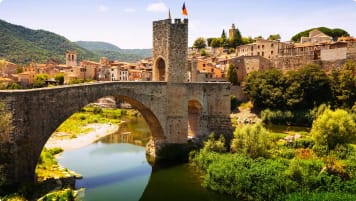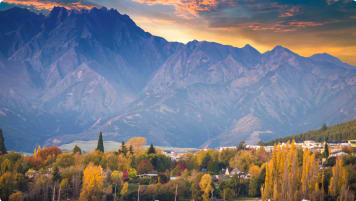Santorini, Crete and Cyprus Small Group Tour | Eastern Mediterranean Islands Tour
A fascinating small group tour, with an amazing mix of culture and history – the islands of Greece, the cradle of Western civilisation, where traces of a centuries-old history exists. Visit Santorini, a remnant of a volcanic era; Crete, the home of the Minoan civilisation with important archaeological finds at Knossos and Phaistos. Rhodes, inhabited since the Stone Age; and venture further to the island of Cyprus, where east meets west.
From A$17,545AUD
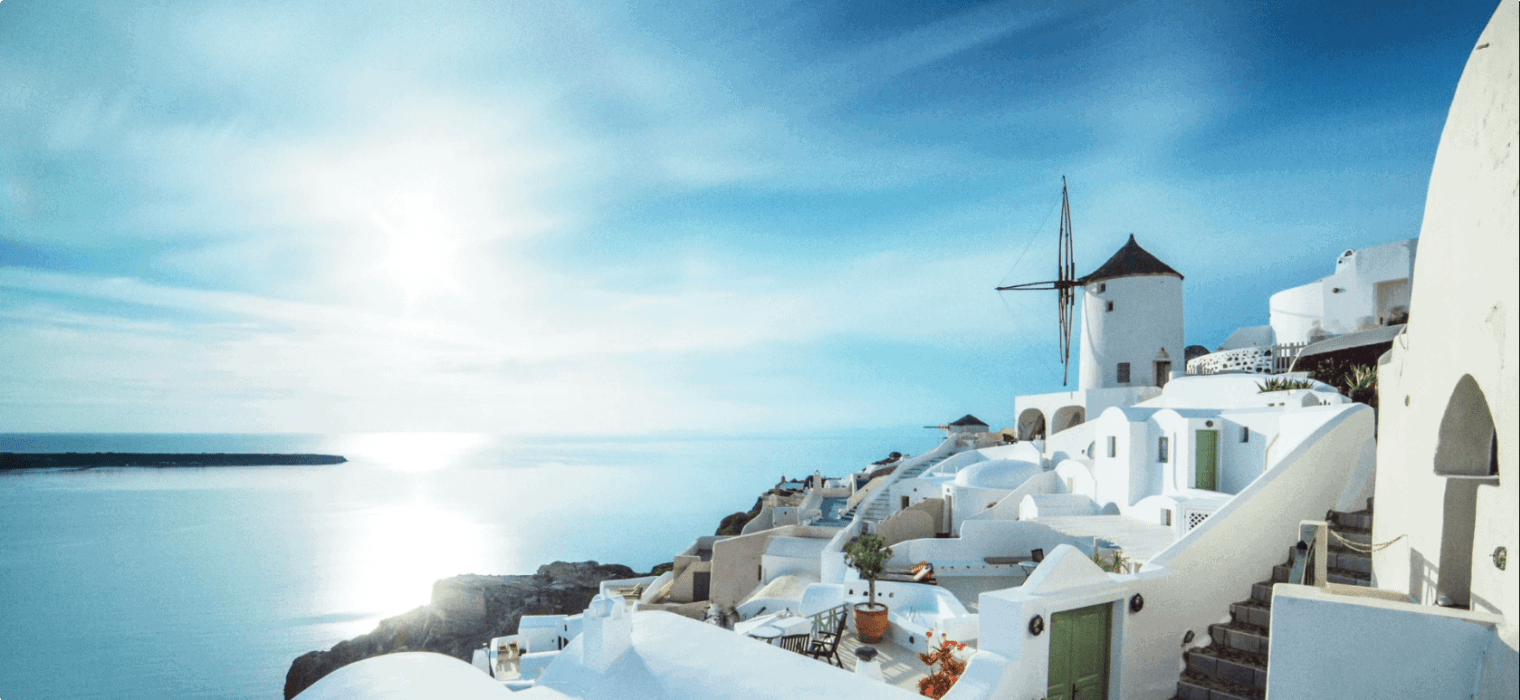
Highlights
- 1. Visit the archaeological sites of Akrotiri, possible site of the lost city of Atlantis.
- 2. In Crete visit the Minoan Palaces of Knossos, Phaistos and Malia.
- 3. Experience Rhodes, including a visit to the fortified Palace of the Grand Masters.
- 4. Spend time in Cyprus visiting Larnaca, Nicosia and the Northern Cyprus sites of Khirokitia and Salamis.

Departure Dates
| Departure Date | Price |
|---|---|
| 13 October 2024 Ends 02 November 2024 • 21 days A$17,545 Twin A$20,450 Single Available | Selected |
| 10 April 2025 Ends 30 April 2025 • 21 days A$18,400 Twin A$21,475 Single Available | |
| 12 October 2025 Ends 01 November 2025 • 21 days A$18,400 Twin A$21,475 Single Available | |
| 09 April 2026 Ends 29 April 2026 • days A$18,400 Twin A$21,475 Single Available | |
| 11 October 2026 Ends 31 October 2026 • days A$18,400 Twin A$21,475 Single Available |
Santorini, Crete & Cyprus Tour | Eastern Mediterranean Islands
On this Eastern Mediterranean tour of Santorini, Crete, and Cyprus, you experience, over the course of 21 days, the exhilarating mix of Greek island culture and history. This educational group tour visits four significant Eastern Mediterranean islands and features amazing voyages into antiquity, strolls through unique landscapes and scenery, a taste of local cuisine, and a discovery of the Eastern Mediterranean's ancient ruins and natural wonders.
On these escorted tours on the Mediterranean Sea, travellers visit one of the Greek isles, beautiful Santorini, which contains a remnant of an ancient civilisation disrupted by volcanic action. On Crete, you explore the home of the Minoan civilisation aided by important archaeological finds at Knossos and Phaistos. You also visit Rhodes, inhabited since the Stone Age, as well as the island of Cyprus, where east meets west.
A selection of professional guides join your Program Leader or tour manager on this trip to share their knowledge of each island visited. As you explore these islands and learn about the cradle of Western civilisation, ancient cultures and history come to life. You take local ferries between the islands and spend an extended time exploring the many wonders that each has to offer.
Santorini, a municipality of Greece, is part of the group of islands called the Cyclades Islands (“circular islands”), located about 200 km (or 120 miles) from the Greek mainland. A single island before the devastating eruption of its volcano, Santorini (then called Thera) was sparsely inhabited during the Neolithic era (circa 4,000 BC, or the last stage of the Stone Age), the early inhabitants perhaps seafarers attracted to Santorini’s rich sea and arable land.
More and more seafarers came and settled in a peninsula at the southwestern end of the island now called “Akrotiri”. These settlers were primarily the ancient Cretans that archaeologists now refer to as the “Minoans”, after the labyrinthine nature of a Bronze Age archaeological site unearthed in Crete, and which was probably the origin of the ancient tale of King Minos and the Minotaur.
Akrotiri grew to become a major urban centre and sea port during the Late Bronze Age (circa 2,000 to 1,627 BC), contributing to the growth of Minoan influence as the routes of commerce brought their culture and art across the Aegean and the Mediterranean. This allowed the Minoans to enjoy a trade relationship with Greece, Crete, Cyprus, Syria, and Egypt.
Around 1,450 BC (the exact date is still being debated amongst historians and archaeologists), the volcano on the island erupted, exploding with the force of several hundred atomic bombs. As the eruption buried Akrotiri, it gave rise to legends in the years that followed. The eruption was probably the source of Plato’s story about the lost city of Atlantis, the plagues described in the Old Testament, and the “yellow fog, dim sun, [and] frost in July” described in the Bamboo Annals of China.
Santorini, Crete & Cyprus small group tour itinerary
The Eastern Mediterranean Islands small group tour will walk you through this history. We begin our adventure in Athens, the home of many Roman ruins and ancient archaeological sites. Its atmosphere has a mixture of classical Greek, Byzantine, Ottoman, and modern architecture, with the great Parthenon as its centrepiece. Ringed by mountains and conveniently located near Piraeus, its Mediterranean port, Athens epitomises both ancient and modern Greece.
From Athens we travel to Santorini. The island remains a stunning example of white washed villages, clinging to volcanic cliffs above black sand beaches. While on Santorini we take a walking tour of Akrotiri. We also visit the Prehistoric Museum of Thera which displays archaeological treasures from Ancient Thera and Akrotiri.
We also take a walking tour of the volcanic island of Nea Kameni in the caldera.
While on Santorini you visit a winery and explore their fascinating vineyards. The vineyards on Santorini are a site to behold as Santorinians use the indigenous grape variety, assyrtiko. As it can get very windy on the island, the residents weave assyrtiko vines into basket shapes low to the ground instead of tying the vines to trellises.
The remainder of our small group tour explores three other islands in the Eastern Mediterranean: Crete, Rhodes and Cyprus. From Santorini we travel to Crete and spend 5 days exploring its natural beauty as well as its many Minoan palace sites. Our tour includes four nights on Rhodes, which has been inhabited since the Stone Age and contains a broad spread of history from ancient times though the medieval period to the present day.
From Rhodes we journey to Cyprus where we spend seven nights. This gives us the chance to explore north Cyprus, including Lanarka and the Khirokitia Neolithic site.
This Eastern Mediterranean Islands History small group tour is for the mature couple or solo traveller curious to learn about the Greek civilisation across the islands. Odyssey Traveller also offers a 10-day short version of this tour, Eastern Mediterranean Islands short tour
If you want to learn more about Greece or Cyprus, visit our country profiles where all the other tour departures are listed as well. For more details, click the ‘Top 5’ or ‘Itinerary’ buttons above! If you’re keen to experience this tour, please call or send an email. Or, to book, simply fill in the form on the right hand side of this page.
Gallery

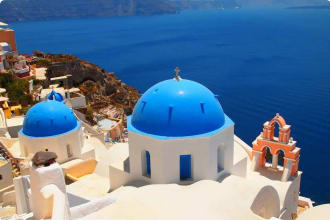

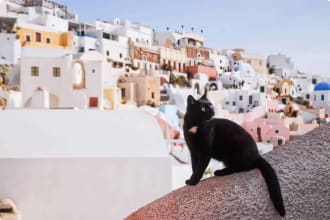
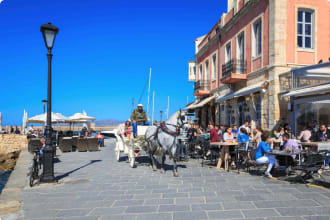
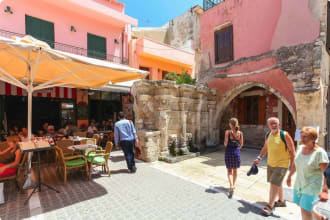
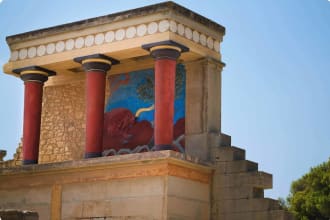
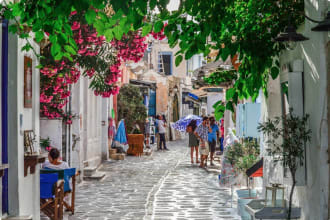
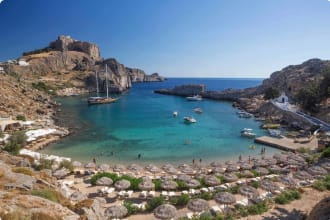
Itinerary
21 days
Day 1: Athens
Accommodation: 1 night at Titania Hotel or similar.
We will begin our tour in Athens, a bustling modern metropolis, home to many of the world’s most famous archaeological sites. The city is a melting-pot of classical Greek, Byzantine, Ottoman, and modern architecture. Ringed by mountains and conveniently located near Piraeus (its Mediterranean port), Athens epitomises both ancient and modern Greece. Upon arrival in Athens, we will arrive to the hotel individually. We will have a meeting with our tour leader at the hotel, followed by a welcome dinner.
Day 2: Santorini
Accommodation: 3 nights at the El Greco Hotel or similar.
After breakfast we will travel to Santorini. Colonised by the Minoans in 3000 BC, this volcanic island erupted in 1450 BC, forming Santorini’s present distinctive crescent shape. The island is widely believed to be a candidate for the lost kingdom of Atlantis. Originally named Thira by the Dorians in the 8th century BC, it was renamed Santorini in honour of St. Irene by the Venetians who conquered the island in the 13th century. The island remains a stunning example of a Cycladic island with white washed villages, clinging to volcanic cliffs above black sand beaches, best explored when the cruise ships have left.
In the afternoon, we will visit the Prehistoric Museum in Fira, which displays archaeological treasures from Ancient Thera, Akrotiri and Potamos.
Day 3: Santorini
Accommodation: El Greco Hotel or similar.
We will take a morning visit to the town of Oia and lunch at Ammoudi, which is 300 steps below Oia. In the afternoon, we will visit the archaeological site of Akrotiri, which was destroyed by a volcanic eruption circa 1613 BC. Our exploration for the day will end with a visit to the site of Ancient Thera.
Day 4: Santorini
Accommodation: El Greco Hotel or similar.
We will take a walking tour of Fira. We will visit Agios Stylianos, which is a chapel clinging to the edge of a cliff, and we will visit the Frankish Quarter, which features a maze of arcaded streets. We will then take an excursion to the volcanic island of Nea Kameni in the caldera.
In the afternoon, we will visit a winery and explore the fascinating vineyards on Santorini. Because it can get very windy on the island, the residents weave vines into basket shapes low to the ground instead of tying vines to trellises.
Day 5: Heraklion
Accommodation: 3 nights at the Ibis Styles Heraklion or similar
In the morning we will take a coach to the airport and fly across to Heraklion, in Crete. We will arrive in Heraklion, in Crete, and transfer to the hotel. Crete is one of the most beautiful and traditional regions of Greece. Although Cretans have fought generations of invaders, they are a people whose courtesy and hospitality to travelers is legendary.
Day 6: Heraklion
Accommodation: Ibis Styles Heraklion or similar
In the morning, we will visit Knossos, which was the capital of Minoan Crete. Knossos was inhabited for several thousand years until its destruction in 1375 BC, which marked the end of Minoan civilization. The palace of Knossos was built circa 1900 BC on the ruins of previous settlements. It was destroyed for the first time along with the other Protopalatial palaces around Crete in 1700 BC, probably by a large earthquake or foreign invaders. It was immediately rebuilt to an even more elaborate complex, and until its abandonment was damaged several times during earthquakes, invasions, and in 1450 BC by the colossal volcanic eruption of Thera. A British archaeologist excavated the site in 1900 AD and restored large parts of the palace. According to Greek mythology, the palace was designed by famed architect Dedalos with such complexity that no one inside could ever find its exit. King Minos, who commissioned the palace, then kept the architect prisoner to ensure that he would not reveal the palace plan to anyone. Dedalos, who was a great inventor, built 2 sets of wings so he and his son Ikaros could fly off the island, and so they did. On their way out, Dedalos warned his son not to fly too close to the sun because the wax that held the wings together would melt. However Ikaros, young and impulsive as he was, flew higher and higher until the sun rays dismantled his wings and the young boy fell to his death in the Aegean sea. The palace is also associated with the legend of Theseus killing the Minotaur.
In the aftrnoon, we will visit the Heraklion Archaeological Museum, which is one of the largest and most important museums in Greece. The museum, located in the town centre, was built on a site previously occupied by the Roman Catholic monastery of Saint Francis, which was destroyed by an earthquake in 1856. The museum’s building is an important example of modernist architecture and was awarded a Bauhaus commendation. The museum’s architect, Patroklos Karantinos, applied the principles of modern architecture to the specific needs of a museum by providing good lighting from the skylights above and along the top of the walls, and facilitating the flow of large groups of people. He also anticipated future extensions to the museum. The museum houses representative artifacts from the Neolithic period to the Roman rimes. The museum’s Minoan collection contains unique examples of Minoan art, many of them true masterpieces.
Later we will take a walking tour of Heraklion, including a visit to the Morosi Fountain, the Bembo Fountain, Venetian Loggia, Agios Titos Church, the Koules Fortress (Venetian), and the if time permits we stop at the local Market.
Day 7: Heraklion
Accommodation: Ibis Styles Heraklion or similar
This morning we will go to the Nikos Kazantzakis Museum, which pays tribute to the important intellectual, author, thinker, philosopher, politician, and traveler, Nikos Kazantzakis, author of “Zorba the Greek.” The museum is made up of a cluster of buildings in the central square of the historical village of Varvari, now known as Myrtia. The museum was founded by set and costume designer Yiorgos Anemoyiannis, a pioneering figure in Greek theatre. His fundamental aim was to preserve the author’s memory and promote his work and thought. Significant assistance was offered by Eleni Kazantzaki, the author’s second wife.
The Museum holds manuscripts and notes by the author; samples of his correspondence with major thinkers, politicians and authors of his time; first editions of his works in Greek and other languages; rare photographic material; souvenirs from his travels; personal effects; models, costumes and other material from theatre productions of his works in Greece and abroad; portraits and sculptures of the author; and dozens of foreign-language editions of his works from all over the world.
We will stop for a wine tasting and lunch. After lunch, we will visit the Minoan Palace of Malia. This is the third-largest Minoan palace in Crete, built in a wonderful setting near the sea on the road linking eastern and central Crete. This palace, which was first constructed circa 1900 BC, was the mythological seat of Minos’s brother Sarpedon. The palace was destroyed and rebuilt numerous times, and today we can walk around the actual palace, just as it was uncovered by archaeological excavations. Most of the ruins visible today belong to the Neopalatial complex – the second palace – whose rooms are set around 3 courts: the Central Court, the North Court and the Tower Court. The majestic size and complex plan of the palace make it a fascinating place to visit.
Day 8: Chania
Accommodation: 2 nights at Hotel Kriti or similar.
We will visit the Minoan Palace at Phaestos. The Palace of Phaestos lies on the east end of Kastri hill at the end of the Mesara plain in Central Southern Crete. To the north lies Psiloritis, the highest mountain in Crete. On the slopes of Psiloritis is the Kamares cave, which was likely a religious or cult centre for Phaestos and the Mesara plain. A very fine pottery style was discovered in this cave from the Middle Minoan period, which has been named Kamares Ware after the cave in which it was found. Kamares Ware has only been found at palace sites like Phaistos and Knossos, suggesting that it was specially produced for whoever was based in the palaces.
A couple of kilometres to the west of Phaistos is the important Minoan site of Ayia Triadha. To the south of Phaistos are the Asterousia mountains beyond which lies the Libyan Sea. To the southwest is Kommos, the ancient port of Phaistos, and to the east, the vast Mesara plain which is the single largest fertile area in Crete and was populated with small settlements and distinctive tholos tombs in Minoan times. We will also visit the mountain village of Zaros which is famous for its natural spring water, and see the Moni Agios Nikolaos at the mouth of the Rouvas Gorge.
Day 9: Chania
Accommodation: Hotel Kriti or similar.
We will take a full day excursion along the west coast. Our first stop will be Rethymo, where we will visit the Venetian fortress and the Old Quarter, including the Rimondi Fountain and the Venetian Loggia.
We will visit Chania to explore Venetian fortifications. We will see the Church of Agios Nikolaos, which the Ottomans converted into a mosque in 1645 until it was returned to an Orthodox Church in 1918. We will also experience the Agora, or covered market. Our final visit for the day will be to the Allied War Cemetery at Souda Bay.
Day 10: Rhodes
Accommodation: Hotel Mediterranean or similar.
Today we will take a local flight and travel to Rhodes.
Rhodes is the capital of the Dodecanese and has been an important centre of civilisation since the 5th century BC. It was part of both the Roman and Byzantine Empires before being conquered by the Knights of St. John, who occupied Rhodes from 1306 to 1522. Ottoman and Italian rule followed, and the island is still rich in cultural history and atmosphere.
On arrival we’ll enjoy a tour of the city, including entrance to the fortified Palace of the Grand Masters, the impressive Archaeological Museum and a visit to the Acropolis.
We end our day with dinner at a local restaurant.
Day 11: Rhodes
Accommodation: Hotel Mediterranean or similar.
Today we continue our exploration of Rhodes with a visit to Kallithea Springs area, located only a few kilometers from the city. The thermal springs have been popular since the 7th century BC. We’ll view the Rotunda build by the italians in the early 1900s and the explore the surrouding area and stunning beach.
Lunch will be at a local restaurant today and the remainder of the afternoon is at leisure.
Day 12: Rhodes
Accommodation: Hotel Mediterranean or similar.
We will explore the ancient city of Lindos and its inspiring acropolis.
The afternoon is at leisure and in the evening we enjoy a group dinner at a local restaurant.
Day 13: Rhodes
Accommodation: Hotel Mediterranean or similar.
Today we visit the ancient city Lalysos, a Doric city that attracted successive invaders over the centuries. Next we will go to the nearby Bee Museum, where we will learn about the history of beekeeping in Rhodes. Next, we will travel on to Petaloudes, the Valley of the Butterflies. We will take a lovely walk along a forest path lined with streams and pools along the way.
Our last visit of the day will be to Kamiros to see the ruins of a Doric city on a hill above the west coast. We will see a Doric temple, houses from the Hellenistic period, and the Temple to Athena.
In the evening we’ll have a group dinner at a local restaurant.
Day 14: Pafos (Cyprus)
Accommodation: King Jason Hotel or similar
Today we take a flight from Rhodes to Larnaca. On arrival we’ll meet our local guide and transfer to Limassol for a walking tour in the area of the Old Port followed by a visit to the Castle. We then continue our journey to Pafos with a stop in Kolossi to visit the Medieval Castle.
In the evening we enjoy a group dinner at the hotel.
Day 15: Pafos
Accommodation: King Jason Hotel or similar
We have a full day exploring Pafos and visit the ancient city of Nea Pafos, where we will see excavated Roman villas and their beautiful mosaics. We will see the houses of Dionysus, Aion, Theseus, and Orpheus, as well as the theatre, Odeon, and Asklepion. We will also see the Necropolis (Tombs of the Kings) from the Ptolemaic Period. Time permitting we will visit Chrysopolitissa, which is a basilica constructed at the end of the 4th century AD.
We stop for lunch at Kourion and later we visit archaeological site which contains remains from Hellenistic, Roman, and early Christian Era.
Day 16: Troodos
Accommodation: Casale Panayiotis or similar
Today we depart Pafos and travel via Omodos where we will visit the Monastery of the Holy Cross, the oldest monastery in Cyprus. We will also have an opportunity to taste homemade kommandaria, which is a local wine that has been made here for over 4,000 years (even Homer wrote about it!).
In the afternoon, we will visit some of the other UNESCO World Heritage listed Byzantine Churches: Archangels Michail, Agios Ioannis Lambadistis Monastery, and Panagia tou Moutoulla.
Note for April departures: If your tour dates fall during Orthodox Easter some visit may be impacted by changed opening times or local closures due to the public holidays. More detailed information will be provided closer to departure.
Day 17: Troodos to Nicosia
Accommodation: Hilton Park Niscosia or similar
We will drive to Nicosia, where we can visit the tiny Byzantine church of Panagia tou Araka that has frescoes dating from 1192. In the afternoon we will visit the Cyprus Handicraft Service and watch pottery, woodwork, embroidery, and a range of other skills. Next we will see Kornesios Mansion, which is a building restored in Ottoman style that shows the lifestyle of upper classes in this period. If time permits, we will also visit the Archaeological Museum.
Lunch will be at a local restaurant in Nicosia.
Day 18: Nicosia
Accommodation: Hilton Park Niscosia or similar
In the morning we will enjoy a walking tour of the Old Town to see the Archbishop’s Palace, and the Agios Ioannis Church. We’ll also visit the Archaeological Museum, which is the oldest and largest in Cyprus. The museum traces the long history of civilization since prehistoric times. After lunch we pause for lunch (own arrangements) we will visit Turkish Nicosia to see the Buyuk Han, the Bedesten, the Mevlevi Shrine Museum, and the Pasha Ethnographic Museum.
Dinner tonight will be at our hotel.
Day 19: Larnaca
Accommodation: Hilton Park Niscosia or similar
We will take a full day excursion to North (Turkish) Cyprus to see the Shipwreck Museum, Salamis ancient site, the Royal Tombs, and Famagusta – “Ghost Town”.
Later in the afternoon we return to the hotel for a group dinner.
Day 20: Larnaca
Accommodation: Hilton Park Niscosia or similar
Today we will visit the traditional lace makers of Lefkara as well as the Khirokitia Neolithic Site and Larnaka Salt Lake. Next to the lake we will see the Hala Sultan Tekkesi Mosque, which is the burial place of the prophet Mohammed’s aunt.
We’ll stop at the Archaeological Museum, it was renovated in 2022 and houses a large collection of archaeological finds from the area.
We will visit the Lazarus Church and the archaeological site of Kition, and return in time for our farewell dinner at the hotel.
Day 21: Larnaca
The tour will conclude today after breakfast.
Tour Notes
- Group size is limited to a maximum of 16 participants.
Includes / Excludes
What’s included in our Tour
- 20 nights of hotel accommodation.
- 20 breakfasts, 7 lunches, and 15 dinners.
- Transport by coach, local flights, ferry travel, and field trips as indicated.
- Applicable entry fees and services of local guides.
- Service charges and gratuities.
- Services of a tour leader.
- Detailed tour information booklet.
What’s not included in our Tour
- Return international airfare and departure taxes.
- Comprehensive travel insurance.
- Items of a personal nature.
Participants must be able to carry their own luggage, climb and descend stairs, be in good health, mobile and able to participate in 3-5 hours of physical activity per day, the equivalent of walking / hiking up to 8 kilometers per day on uneven ground.
Book now
Make it a private tour
Easing your journey
Crossing international borders with restrictions
The list of requirements to travel internationally has changed and will continue to change for several years. Odyssey is here to assist you in managing your way through these requirements:
For more information see our Crossing international borders with restrictions page.
Book With Confidence
If less than 30 days before your tour starts you are unable to travel as a result of Government travel restrictions, Odyssey Traveller will assist you with a date change, provide you with a credit or process a refund for your booking less any non-recoverable costs.
See Terms and conditions for details.
Peace of Mind Travel
The safety of our travellers, tour leader, local guide and support staff has always been our top priority and with the new guidelines for public health and safety for keeping safe for destinations around the world, we’ve developed our plan to give you peace of mind when travelling with us.
See Peace of Mind Travel for details.
Reading List Download PDF
A Brief History of Greece
Christos Visvardis
From the Neolithic Period to today's economic crisis, via Ancient Athens, the Persian Wars, Alexander the Great, the Byzantine Empire and two world wars, this book narrates the history of Greece with all the significant events that shaped it.
The Islands of the Eastern Mediterranean: A History of Cross-Cultural Encounters
Özlem Çaykent (Editor), Luca Zavagno (Editor)
The Mediterranean, or ‘Middle Sea’, has long been regarded as the symbolic centre of European civilization. The binding water between Turkey, the Middle East, the trading communities of North Africa, and the European powerhouses Italy, France and Greece, a history of this sea is a new and vital way of understanding the history of the societies which have flourished in the region. The Islands of the Eastern Mediterranean charts the story of the water as both connector and border, and analyses the islands role in world history. From Mehmed II’s efforts to conquer the old Roman Empire, through the claims of Rhodes and the role of the Aegean Islands in Ottoman international relations, to the British in Cyprus and the present-day tensions surrounding the region.
Experiencing Dominion: Culture, Identity, and Power in the British Mediterranean
Thomas W. Gallant
Experiencing Dominion pushes contemporary literature on historical anthropology in a new direction by moving the discussion away from an emphasis on a simple polarity between hegemony and resistance, and instead focusing on the shared interactions between colonizers and colonized, rulers and ruled, foreigners and locals. In this important study, Gallant emphasizes contingency and historical agency, examines intentionality, and explores the processes of accommodation and, when warranted, resistance. In so doing, he reconstructs the world Britons and Greeks made together on the Ionian Islands during the nineteenth century through their shared experience of dominion.
Islands of the Eastern Mediterranean (American Geographical Society - Around the World Program)
Jay and Marcia Forman
AmazonThe Eastern Mediterranean and the Making of Global Radicalism, 1860-1914
Ilham Khuri-Makdisi
In this groundbreaking book, Ilham Khuri-Makdisi establishes the existence of a special radical trajectory spanning four continents and linking Beirut, Cairo, and Alexandria between 1860 and 1914. She shows that socialist and anarchist ideas were regularly discussed, disseminated, and reworked among intellectuals, workers, dramatists, Egyptians, Ottoman Syrians, ethnic Italians, Greeks, and many others in these cities. In situating the Middle East within the context of world history, Khuri-Makdisi challenges nationalist and elite narratives of Mediterranean and Middle Eastern history as well as Eurocentric ideas about global radical movements. The book demonstrates that these radical trajectories played a fundamental role in shaping societies throughout the world and offers a powerful rethinking of Ottoman intellectual and social history.
The Collapse of the Eastern Mediterranean: Climate Change and the Decline of the East, 950-1072
Ronnie Ellenblum
As a 'Medieval Warm Period' prevailed in Western Europe during the tenth and eleventh centuries, the eastern Mediterranean region, from the Nile to the Oxus, was suffering from a series of climatic disasters which led to the decline of some of the most important civilisations and cultural centres of the time. This provocative study argues that many well-documented but apparently disparate events - such as recurrent drought and famine in Egypt; mass migrations in the steppes of central Asia; and the decline in population in urban centres such as Baghdad and Constantinople - are connected and should be understood within the broad context of climate change. Drawing on a wealth of textual and archaeological evidence, Ronnie Ellenblum explores the impact of climatic and ecological change across the eastern Mediterranean in this period, to offer a new perspective on why this was a turning point in the history of the Islamic world.
The Histories: Complete
Herodotus
Herodotus was an ancient Greek historian who lived in the fifth century BC (c.484 - 425 BC). He has been called the "Father of History", and was the first historian known to collect his materials systematically, test their accuracy to a certain extent and arrange them in a well-constructed and vivid narrative. The Histories-his masterpiece and the only work he is known to have produced-is a record of his "inquiry", being an investigation of the origins of the Greco-Persian Wars and including a wealth of geographical and ethnographical information. The Histories, were divided into nine books, named after the nine Muses: the "Muse of History", Clio, representing the first book, then Euterpe, Thaleia, Melpomene, Terpsichore, Erato, Polymnia, Ourania and Calliope for books 2 to 9, respectively.
Crete: the Battle and the Resistance
Antony Beevor
Acclaimed historian and best-selling author Antony Beevor vividly brings to life the epic struggles that took place in Second World War Crete - reissued with a new introduction. The Germans expected their airborne attack on Crete in 1941 - a unique event in the history of warfare - to be a textbook victory based on tactical surprise. They had no idea that the British, using Ultra intercepts, knew their plans and had laid a carefully-planned trap. It should have been the first German defeat of the war, but a fatal misunderstanding turned the battle round. Nor did the conflict end there. Ferocious Cretan freedom fighters mounted a heroic resistance, aided by a dramatic cast of British officers from Special Operations Executive.
Atlantis of the Minoans and Celts
Lee Kerr
A travel adventure investigating the Atlantis story, exploring the evidence from Ireland to Iraq, examining ancient artifacts, Bronze Age archaeological sites, and historical locations.
You know the story of Atlantis, or at least you think you do. The Story of Atlantis is one of the greatest historical and archeological unsolved mysteries of human history. Did Atlantis exist, and if so, where? Many sites are suggested, but is any the real location of Atlantis?
Accompany this detective attorney, historian and archeology investigator on his personal quest For answers, exploring and unraveling the evidence from the Atlantis mystery. Join him as he examines the archaeological sites, artifacts, and museums, covering 4000 years of history, on his investigative journey!
Join the investigation in Santorini, Crete, Athens, and Ireland as he builds his case for the origins of Atlantis. Enjoy the photography and experience the islands of Ireland, Santorini and Crete as he guides you through Plato's Atlantis story. Follow him as he ties the Atlantis clues of mythology, history, archeology, geology, language, and genetics back to ancient relationships with Egypt, Spain, and Ireland, for a new, broader, compelling understanding of Plato's Atlantis!
Share the experience of exploring and connecting the archeological evidence of Bronze Age Griffins, (flying eagle headed lions), Dwarf Elephants, and Blue Monkeys to the Atlantis story. Uncover with the author the evidence for the three "The Pillars of Heracles" locations, and find out which site belongs to the actual site of Atlantis.
Travel with the author as he analyzes the evidence, ties the clues together, and reveals an ancient Atlantis far more diverse, complex, and intriguing than previously understood.
The Cyprus Problem: What everyone needs to Know
James Ker-Lindsay
For nearly 60 years--from its uprising against British rule in the 1950s, to the bloody civil war between Greek and Turkish Cypriots in the 1960s, the Turkish invasion of Cyprus in the 1970s, and the United Nation's ongoing 30-year effort to reunite the island--the tiny Mediterranean nation of Cyprus has taken a disproportionate share of the international spotlight. And while it has been often in the news, accurate and impartial information on the conflict has been nearly impossible to obtain.
In The Cyprus Problem: What Everyone Needs to Know®, James Ker-Lindsay--recently appointed as expert advisor to the UN Secretary-General's Special Advisor on Cyprus--offers an incisive, even-handed account of the conflict. Ker-Lindsay covers all aspects of the Cyprus problem, placing it in historical context, addressing the situation as it now stands, and looking toward its possible resolution. The book begins with the origins of the Greek and Turkish Cypriot communities as well as the other indigenous communities on the island (Maronites, Latin, Armenians, and Gypsies). Ker-Lindsay then examines the tensions that emerged between the Greek and Turkish Cypriots after independence in 1960 and the complex constitutional provisions and international treaties designed to safeguard the new state. He pays special attention to the Turkish invasion in 1974 and the subsequent efforts by the UN and the international community to reunite Cyprus. The book's final two chapters address a host of pressing issues that divide the two Cypriot communities, including key concerns over property, refugee returns, and the repatriation of settlers. Ker-Lindsay concludes by considering whether partition really is the best solution, as many observers increasingly suggest.
Written by a leading expert, The Cyprus Problem brings much needed clarity and understanding to a conflict that has confounded observers and participants alike for decades.
Divided Cyprus: Modernity, History, and an Island in Conflict
Yiannis Papadakis, Nicos Peristianis
"[U]shers the reader into the complexities of the categorical ambiguity of Cyprus [and]... concentrates... on the Dead Zone of the divided society, in the cultural space where those who refuse to go to the poles gather." ―Anastasia Karakasidou, Wellesley College
The volatile recent past of Cyprus has turned this island from the idyllic "island of Aphrodite" of tourist literature into a place renowned for hostile confrontations. Cyprus challenges familiar binary divisions, between Christianity and Islam, Greeks and Turks, Europe and the East, tradition and modernity. Anti-colonial struggles, the divisive effects of ethnic nationalism, war, invasion, territorial division, and population displacements are all facets of the notorious Cyprus Problem. Incorporating the most up-to-date social and cultural research on Cyprus, these essays examine nationalism and interethnic relations, Cyprus and the European Union, the impact of immigration, and the effects of tourism and international environmental movements, among other topics.
Slaughter us all and make our blood a river….: Cyprus Poetry and History
Andreas Melas
Poetry from Cypriot poet Vasilis Michaelides on the events leading to the massacre of nearly five hundred Greek Cypriot clergy and leaders on July 9, 1821. Not merely historical or poetical but high drama in the battle of the minds between the Greek Orthodox Archbishop and the Ottoman Turkish Governor. The Turkish governor was authorized to slaughter all of the Greek Cypriot leadership from the clergy to the laity. The Archbishop was offered a way out to save himself. But if he did then what would happen? The author incorporates sufficient historical and other background to enable the reader to appreciate this epic poem and the context behind it. Turkish invasions and interventions in the island of Cyprus during the past five centuries are highlighted.
The Chronological History of Cyprus 1489-2015
Marros Adamides
A chronological history of Cyprus from 1489 (Cyprus was then under the Venetian Republic) to 2015, covering the Ottoman domination which lasted 307 years, the British rule from 1878 to 1960 and 55 years of independence of the Republic of Cyprus, which is covered in more detail ending in the financial crisis of 2010-2015.
A Cook's Tour of Cyprus
Maurice Hassall
A witty, commendable book that will wrap you in the cosy comfort of Cypriot culture. It will remain as a permanent souvenir of your time on the Island of Aphrodite. As background reading prior to your first visit it will drive you inquisitively to bring added pleasure to your holiday or business trip. It is a humorous guide through Cypriot cuisine and designed to make you knowledgeable of Cypriot culinary art without being burdened with tiresome recipes and methods. A perfect companion for every excellent or diabolical cook!! The manuscript is composed of short rib tickling stories written as the author travels the length and breadth of Cyprus. The book is informative and will also fill your sombre moments with laughter.
Captain Corelli’s Mandolin
Louis de Bernieres
Extravagant, inventive, emotionally sweeping, Corelli's Mandolin is the story of a timeless place that one day wakes up to find itself in the jaws of history. The place is the Greek island of Cephallonia, where gods once dabbled in the affairs of men and the local saint periodically rises from his sarcophagus to cure the mad. Then the tide of World War II rolls onto the island's shores in the form of the conquering Italian army.
Caught in the occupation are Pelagia, a willful, beautiful young woman, and the two suitors vying for her love: Mandras, a gentle fisherman turned ruthless guerilla, and the charming, mandolin-playing Captain Corelli, a reluctant officer of the Italian garrison on the island. Rich with loyalties and betrayals, and set against a landscape where the factual blends seamlessly with the fantastic, Corelli's Mandolin is a passionate novel as rich in ideas as it is genuinely moving.
The Corfu Trilogy
Gerald Durrell
The trilogy that inspired ITV's six part television series The Durrells. Three classic tales of childhood on an island paradise - My Family and Other Animals, Birds, Beasts and Relatives and The Garden of the Gods by Gerald Durrell - are available in a single edition for the first time in The Corfu Trilogy. Just before the Second World War the Durrell family decamped to the glorious, sun-soaked island of Corfu where the youngest of the four children, ten-year-old Gerald, discovered his passion for animals: toads and tortoises, bats and butterflies, scorpions and octopuses. Through glorious silver-green olive groves and across brilliant-white beaches Gerry pursued his obsession . . . causing hilarity and mayhem in his ever-tolerant family. Durrell's memories of those enchanted days gave rise to these three classic tales, loved by generations of adults and children alike, which are now available in one volume for the first time.
The Greeks: History, Culture, and Society
Ian Morris (Author), Barry B. Powell (Author)
Organized chronologically, this text presents a complete picture of Greek civilization as a history and features sections on the art, architecture, literature, and thought of each period.
The Great Sea: A Human History of the Mediterranean
David Abulafia
Connecting Europe, Asia, and Africa, the Mediterranean Sea has been for millennia the place where religions, economies, and political systems met, clashed, influenced and absorbed one another. In this brilliant and expansive book, David Abulafia offers a fresh perspective by focusing on the sea itself: its practical importance for transport and sustenance; its dynamic role in the rise and fall of empires; and the remarkable cast of characters-sailors, merchants, migrants, pirates, pilgrims-who have crossed and re-crossed it.
Ranging from prehistory to the 21st century, The Great Sea is above all a history of human interaction. Interweaving major political and naval developments with the ebb and flow of trade, Abulafia explores how commercial competition in the Mediterranean created both rivalries and partnerships, with merchants acting as intermediaries between cultures, trading goods that were as exotic on one side of the sea as they were commonplace on the other. He stresses the remarkable ability of Mediterranean cultures to uphold the civilising ideal of convivencia, "living together."
Empires of the Sea: The Final Battle for the Mediterranean, 1521-1580
Roger Crowley
In 1521, Suleiman the Magnificent, Muslim ruler of the Ottoman Empire, dispatched an invasion fleet to the Christian island of Rhodes. This would prove to be the opening shot in an epic clash between rival empires and faiths for control of the Mediterranean and the center of the world. In Empires of the Sea, acclaimed historian Roger Crowley has written a thrilling account of this brutal decades-long battle between Christendom and Islam for the soul of Europe, a fast-paced tale of spiraling intensity that ranges from Istanbul to the Gates of Gibraltar. Crowley conjures up a wild cast of pirates, crusaders, and religious warriors struggling for supremacy and survival in a tale of slavery and galley warfare, desperate bravery and utter brutality. Empires of the Sea is a story of extraordinary color and incident, and provides a crucial context for our own clash of civilisations.
Santorini, Crete and Cyprus Small Group Tour | Eastern Mediterranean Islands Tour

